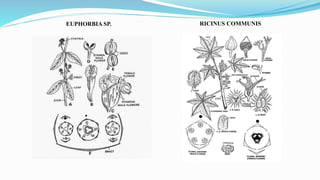Euphorbiaceae ppt
- 1. Dr. B. KARUNAI SELVI ASSISTANT PROFESSOR OF BOTANY V.V.VANNIAPERUMAL COLLEGE FOR WOMEN VIRUDHUNAGAR- 626 001 TAMIL NADU, INDIA
- 2. VEGETATIVE CHARACTERS - HABIT DISTRIBUTION : Found throughout the World HABIT : Herbs - Euphorbia hirta, E. thymifolia, E. helioscopica, E. peplus; E. heterophylla, E. cristata, E. elegans; Phyllanthus niruri, Croton sp., Acalypha indica, etc., are annual or perennial herbs. Shrubs - Euphorbia pulcherrima, E. splendens, - beautiful shrubs. Pedilanthus sp., and Jatropha sp., are shrubby plants. Cactus like shrubs - Euphorbia royleana, E. tirucalli. Tree - Phyllanthus emblica, Bischofia javanica, Putranjiva roxburghii, etc. Small tree - Ricinus communis. Havea brasiliensis - large tree 60 to 100 feet in height and 8-12 feet in girth. Tragia sp. are tropical climbers. Members possess large laticiferous vessels which contain latex.
- 3. VEGETATIVE CHARACTERS – ROOT AND STEM ROOT: Tap and branched. The roots of Manihot utilissima and M .palmata are tuberous and rich in starch. STEM: Herbaceous or woody and erect. Tragia - Climber. Xylophylla sp. possess flat phylloclades. The stem is branched - cylindrical, angular or flat. Ricinus communis – hollow stem. Many stems possess spines. Euphorbia sp., stem - fleshy, green and cactus like in appearance.
- 4. VEGETATIVE CHARACTERS – LEAVES LEAVES: The arrangement is usually alternate , opposite in Euphorbia hirta. In Pedilanthus the leaves are arranged alternately in the lower region of the plant whereas opposite in the floral region. Usually the leaves are simple but in some they are deeply incised, e.g., Ricinus, Manihot, etc. In many Euphorbia the leaves are scaly and caducous. In many cases the leaves are reduced to spines but in few cases the leaves are replaced by cladodes. Leaves are stipulate. In Jatropha sp., the stipules become branched and hair-like. In many Euphorbia sp., they are represented by glands or spines.
- 5. FLORAL CHARACTERS - INFLORESCENCE It may be racemose or cymose or sometimes complex. In Euphorbia, the inflorescence is - cyathium. This is the modification of a cyme. Cyathium inflorescence - male flowers represented by a stalked stamen are found arranged around a central stalked female flower. The female flower consists of gynoecium only. The complete inflorescence looks like a single flower. The bracts are being arranged like a perianth. The bracts are so united that they form a cup-like structure.
- 6. INFLORESCENCE AND FLOWER In Acalypha the inflorescence is catkin type. In Croton and Ricinus the flowers are arranged in terminal racemes. In Jatropha the inflorescence is of cymose type and the flowers are arranged in terminal cymes. In Manihot the flowers are being arranged in racemes. FLOWERS The flowers are always unisexual. They are much reduced and may be monoecious or dioecious. In Euphorbia sp., each male flower is represented by a single stalked stamen. The flowers are incomplete, regular, actinomorphic and hypogynous.
- 7. FLORAL CHARACTERS CALYX AND COROLLA In majority of cases either calyx or corolla or both are absent. In Euphorbia hirta both the whorls of calyx and corolla are absent. In Ricinus communis the calyx is present and the corolla is absent. But calyx and corolla are present, e.g., Croton and Jatropha sp., PERIANTH In Acalypha indica the perianth is represented by four minute sepaloid petals. In Phyllanthus only sepaloid perianth is present. In Euphorbia the perianth is absent or represented by tiny scaly structures. The perianth consists of 4 to 5 petals. The calyx and corolla consists of 4 or 5 sepals or petals. The aestivation is valvate or imbricate.
- 8. FLORAL CHARACTERS - ANDROECIUM In Euphorbia a single stalked stamen represents a single male flower. In Ricinus sp., usually five stamens are present, each stamen is profusely branched. In Jatropha they are arranged in two whorls each of five stamens. The stamens are indefinite, e.g., Croton. The filaments may be free or united. The anthers are dithecous. They dehisce either by apical pores or by transverse or longitudinal slits.
- 9. FLORAL CHARACTERS - GYNOECIUM Three carpels (tricarpellary) Syncarpous Trilocular ovary Superior Each locule contains one or two pendulous Anatropous ovules Axile placenation
- 10. FRUITS The fruits are schizocarpic. The fruits break violently and dehisce into one seeded cocci. Such type of fruit is termed regma which is characteristic of Ricinus sp. The sp., of Trewia and Bridelia bear drupe fruit. Phyllanthus emblica bears drupe.
- 11. SEEDS AND POLLINATION SEEDS The seed is endospermic. In Ricinus caruncle develops from the micropyle. The cotyledons either lie flat or are folded within the endosperm. POLLINATION Entomophilous, i.e., through the agency of insects. In many species the leaves and bracts become coloured and showy to attract the insects. Cross- pollination takes place. Anemophily is also found.
- 14. Some commen species of Euphorbiaceae members EUPHORBIA TIRUCALLI EUPHORBIA HIRTAPHYLLANTHUS AMARUSRICINUS COMMUNIS EUPHORBIA PULCHERRIMA EUPHORBIA SP.
- 16. THANK YOU















